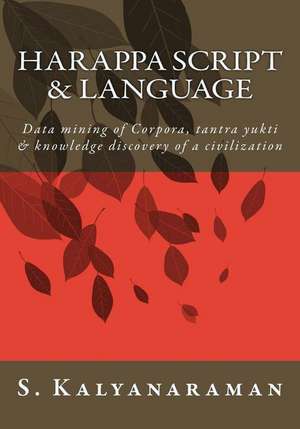Harappa Script & Language
Autor S. Kalyanaramanen Limba Engleză Paperback
Preț: 221.96 lei
Nou
Puncte Express: 333
Preț estimativ în valută:
42.47€ • 44.46$ • 35.35£
42.47€ • 44.46$ • 35.35£
Carte tipărită la comandă
Livrare economică 31 martie-14 aprilie
Preluare comenzi: 021 569.72.76
Specificații
ISBN-13: 9780991104871
ISBN-10: 0991104870
Pagini: 800
Dimensiuni: 178 x 254 x 40 mm
Greutate: 1.36 kg
ISBN-10: 0991104870
Pagini: 800
Dimensiuni: 178 x 254 x 40 mm
Greutate: 1.36 kg
Notă biografică
Dr. S. Kalyanaraman is engaged in creating an Indian Ocean Community, a National Water Grid for India and formulation of sreni dharma as an alternative corporate form. He is well-versed in Kannada, Telugu, Tamil, Hindi and Sanskrit languages. His 7-volume encyclopaedic work on Sarasvati Civilization was published in 2004. The 7 volumes are: Sarasvati: Civilization; Sarasvati: Rigveda; Sarasvati: River; Sarasvati: Bharati; Sarasvati: Technology; Sarasvati: Language; Sarasvati: Epigraphs. He has cracked the code of Sarasvati hieroglyphs (now called Harappa of Indus Script) as artisan guilds' activities related to minerals, metals, furnaces and artifacts of metals in a transition from chalcolithic to alloy (bronze/brass) phase of civilization. He presented his research findings on Sarasvati in the World Sanskrit Conference held in Bangalore in 1996. He has published 15 volumes on Sarasvati civilization and language/writing system (including Indian Lexicon a comparative dictionary of over 25 ancient Indian languages). All the books are also available as ebooks, online: IndianLexicon.pdf. Over 600 monographs are posted on academia.edu. He has participated in many international conferences on civilizations studies including the Indian Ocean Conference held in Singapore in 2016.
